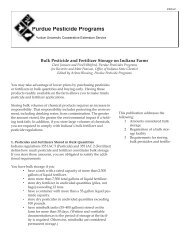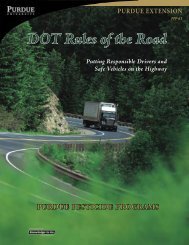Pesticides and Risk Communication PPP-52 - Purdue Pesticide ...
Pesticides and Risk Communication PPP-52 - Purdue Pesticide ...
Pesticides and Risk Communication PPP-52 - Purdue Pesticide ...
You also want an ePaper? Increase the reach of your titles
YUMPU automatically turns print PDFs into web optimized ePapers that Google loves.
including pesticides. EPA must incorporate scientific<br />
information, policy guidelines, <strong>and</strong> professional<br />
judgment in estimating whether a pesticide can be<br />
used beneficially within the limits of acceptable risk.<br />
A product is assumed safe from a scientific point of<br />
view if associated risks are minimal. However, the<br />
following four points must prevail to substantiate that<br />
assumption:<br />
• Conditions must not change to the extent that<br />
the assumptions <strong>and</strong> methods used in the<br />
supportive risk assessment may be rendered<br />
invalid.<br />
• The user must follow label directions explicitly.<br />
• The product must perform as anticipated, once<br />
it is released into the environment.<br />
• Use of the product must not create adverse<br />
effects previously undetected in lab <strong>and</strong> field<br />
test data used for risk assessment.<br />
Can the Line Be Drawn at<br />
20<br />
All?<br />
When asking where to draw the line, start with the<br />
question, Is it safe? In reality, we will never know with<br />
complete certainty that a pesticide is or is not safe: the line<br />
between safe <strong>and</strong> dangerous is never as defined in real life<br />
as it is in science. <strong><strong>Pesticide</strong>s</strong> are developed to work with<br />
reasonable certainty <strong>and</strong> minimal risk. But they exist in a<br />
world of what ifs that loom outside the realm of verifiable<br />
scientific information; <strong>and</strong> often it is the what ifs that alert<br />
policymakers to data gaps.<br />
Based on evaluation of the best data available on a<br />
pesticide at a particular point in time, scientists can state in<br />
all honesty that no significant problems exist with it. But in<br />
reality there are many reasons why we may never know<br />
whether it is safe under all circumstances, nor can we<br />
predict with certainty its performance in hypothetical or future<br />
situations. Scientific investigation is bound by the tools <strong>and</strong><br />
techniques available, <strong>and</strong> new developments continually<br />
redefine our capabilities.




